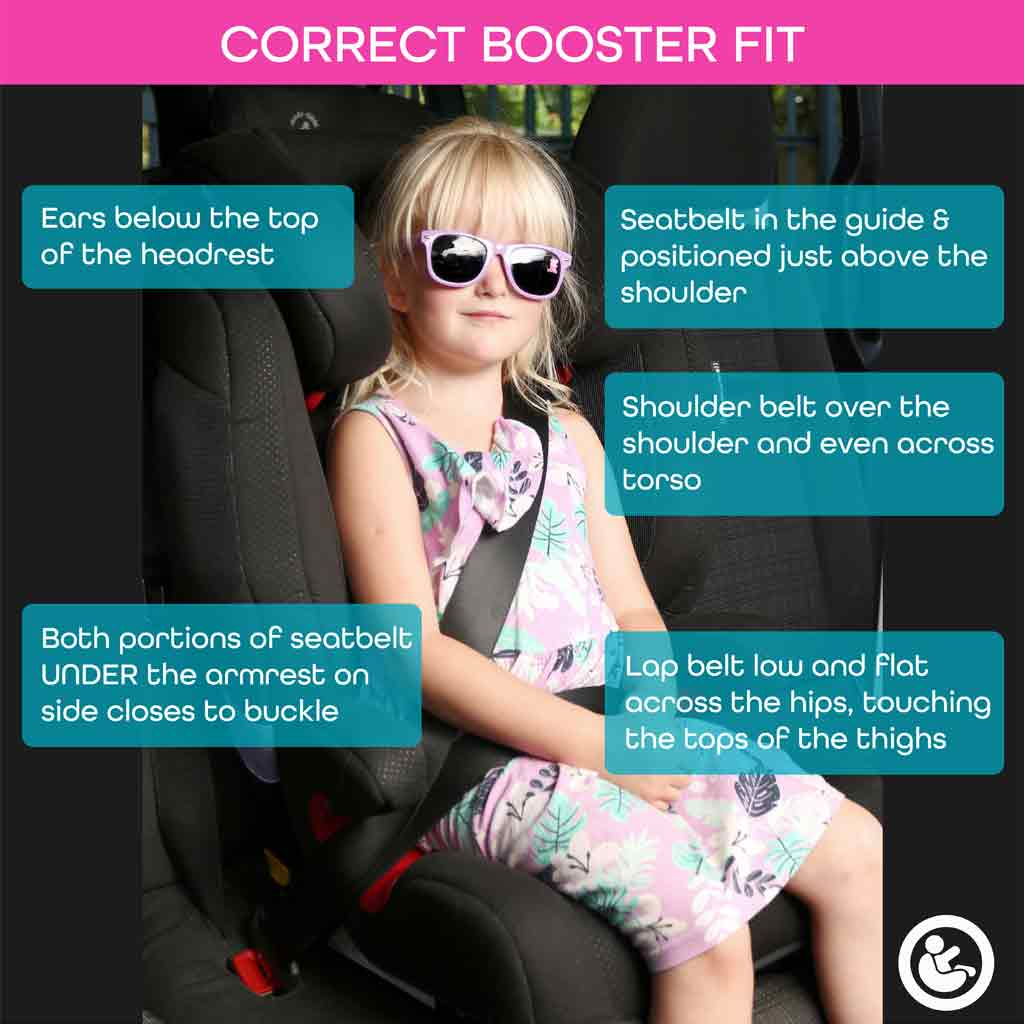

WRITTEN BY JULIE MONSON
Occupational Therapist &
Certified Car Seat Technician
WHY DO CHILD CHILDREN NEED BOOSTERS?
Seatbelts are designed to protect adults over 1.5m tall, and indeed they have saved many adults' lives. However, in a shorter child, seatbelts alone do not provide adequate protection and can cause severe or even fatal injuries.
Children strapped with just a seatbelt and no booster seat before they are tall enough (1.5m) to achieve a safe seatbelt fit were found to be 3 times more likely to be injured in a crash than adults.
This is because of how a seatbelt fits poorly across a child's body. The shoulder belt gets positioned too close to a child's neck, where their spinal cord and vital arteries are. And the lapbelt is positioned over their tummies, where their organs are.
A booster seat is a belt positioning devices, designed to position the seatbelt safely across children's bodies, to get a safer seatbelt fit. The cushion of a booster raises a child up on the vehicle bench, in order to get a safer lapbelt fit. It guides the lapbelt over the child's hard hip bones, rather than over their soft tummy,. The red/green seatbelt guides on highback boosters also position the shoulder belt into a safer position across your child's shoulder and ribcage rather than close to the neck.
In a highback booster, your child is restrained by the seatbelt. Their torso is protected by the side wings of the booster. Their head & neck are protected by the headrest of the booster. Highback boosters offer better protection than backless boosters.

IS IT LEGAL FOR A CHILD NOT TO USE A BOOSTER SEAT?
In South Africa, it only became law that children need to be strapped into a car seat in 2015. It is now illegal to for a child under 3 years to travel without being strapped into a suitable car seat. Regrettably, the Law does not stipulate that children over the age of 3 need to travel in a car seat or booster, for their safety. In South Africa, children over 3 years are required to be strapped into either a car seat/booster if one is available, or at the very least with a seat belt at all times. It IS illegal for a child to be unrestrained in a car.
However, we are still very far behind first world countries, where it is illegal for children to travel without a booster until they are 1.35m. It is still recommended abroad that children continue using a booster until they reach 1.5m, as that is what has been proven to be safest.
Just because it is legal for a child over 3 years to travel without a booster seat, does NOT mean it is safe.

HOW LONG SHOULD CHILDREN USE BOOSTERS?
Although the Law does not differentiate between a child being strapped with a normal seat belt and a child car seat/booster, crash testing shows that children under 1.5m are MUCH safer in car seats or boosters.
It is therefore recommended that children over 1m use boosters until they reach 1.5m and pass the 5-step test. For most children, this is only when they are 10-12 years old.
 Photo credit: The Car Seat Lady
Photo credit: The Car Seat LadyWHAT HAPPENS TO A CHILD WITHOUT A BOOSTER ?
Children can suffer serious neck and head injuries and/or perforated intestines when using a seatbelt alone. This pattern of injury has become known as “seat belt syndrome” by doctors who regularly face this pattern of injury in children.
 Photo credit: Cell Code
Photo credit: Cell CodeIn a collision, the weight of the child is multiplied by the speed the vehicle is traveling. As an example, an 18kg child traveling at 60km per hour would require 1080kg of restraining force to keep that child restrained during the crash.
An improperly restrained or unrestrained child would be propelled into the back of the front seat, the dash or windshield, another passenger or be thrown out of the vehicle via a window or sun-roof.
A child who is shorter than 1.5m causes the lap portion of the seat belt to move up to their abdomen. If they are in a lap-only belt or put the shoulder portion behind them or under their arm; they lose upper body restraint causing abdominal, spinal and/or head injuries.
"The body is propelled forward, jack-knifing over the lap-belt causing serious internal injuries. Then the head strikes the back of the front seat, rolling backward as the body continues in its downward arc, breaking the neck. The spine stretches and the spinal cord can be damaged. The 18kg child in the example would sustain approximately 1080kg of crushing force against their abdomen
The child could sustain a lacerated liver, spleen or bowel, a ruptured bladder, and internal bleeding. Many of these internal injury symptoms don’t present themselves at the time of injury. An occult bleed may not be detected until hours after a crash." (SafeRide4Kids)
TRIGGER WARNING. The video below is a real life story. Watch this dad's plea to parents to avoid regret and to use booster seats to protect their children.
WHAT IS AN UNSAFE SEATBELT FIT?
A child under 1.5m cannot achieve a safe seatbelt fit without the use of a booster. The lapbelt will lie over the abdomen, which could damage the internal organs. The shoulder belt will be placed dangerously close to their neck which can result in spinal cord and/or head injury.

WHEN SHOULD CHILDREN USE BOOSTERS?
When your child is close to outgrowing their toddler seat, it is time to start considering a booster seat. A toddler car seat harness is outgrown when the maximum weight or height is reached. For most toddler car seats sold in South Africa, toddler mode (Group I) is outgrown around 4 years old at 18kg or approximately 105cm. There are only a handful of toddler seats that are approved to use the 5-point harness to 25kg, so be sure to check your car seat manual for the maximum Group 1 limits.
A child needs to be at least 15kg and 100cm tall to fit a booster seat. 4 years is the minimum recommended age to move to a booster. However, if your child still fits their toddler seat’s height and weight limits, don’t be in a rush to move to a booster. It is important that a child is mature enough to sit still and upright at all times in a booster, before they are safe to travel in one. If your child does not yet meet the minimum requirements to use a booster safely, there are alternative options.
In order for your child to fit and use a booster safely, they must meet these minimum criteria:
- At least 4 years old
- At least 100cm tall
- Weigh at least 15kg
- Be able to sit still and upright at all times
- Get a safe seatbelt fit

WHAT IS A SAFE SEATBELT FIT WITH A BOOSTER?
It is only possible for a child under 1.5m to fit a seatbelt safely with the aid of a booster. Once a child outgrows their toddler seat, usually around 4 years, they should move to a highback booster when they reach 100cm and 15kg minimum.
A safe seatbelt fit with a booster:
- Ears should be below the top of the headrest
- Seatbelt in the guide and positioned just above the shoulder (not cutting in the neck) and even across the torso.
- Both portions of seatbelt UNDER the armrest on side closest to buckle
- Lap belt should be low and flat across the hips, touching the tops of the thigh NOT over the abdomen

SAFEST BOOSTERS
We sell the highest safety rated boosters at Precious Cargo

Booster Seat Collection
Click the button below to view our collection of the highest safety rated boosters that we sell
BUY NOWREFERENCES
https://saferide4kids.com/blog/seat-belt-syndrome/
https://www.goodeggcarsafety.com/blog/tags/booster-seats.html
